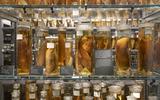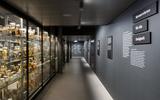3. Preserving for eternity
Building and maintaining a scientific collection is an art in itself. If animal and plant matter is not properly preserved, it will be destroyed by bacteria, mould or insects, fade in the light or rot.
Wet collections such as our «Cabinet of curiosities» require preservatives such as alcohol and formaldehyde, controlled lighting, and cool temperatures, airtight seals and the right air humidity in order to prevent the specimens from decomposing. The collection must be preserved and available for future generations.
3.1 Pale frog
Improper storage has destroyed the pigments in this frog’s skin: Prolonged exposure to light and high room temperature have given it a bleached appearance. The undamaged specimen was kept in a cool, dark place – the same conditions as in our «Cabinet of curiosities».
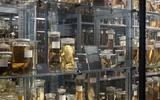
3.2 Collections and the ravages of time
The collection built up by naturalist Emil Göldi is both a useful historical reference and a good example of the effort required to preserve a collection over a long period of time. Between 1898 and 1911, Göldi, a pioneer of exploration in the Amazon region, sent 9,645 insects, 2,964 birds, 987 mammals and a variety of reptiles, fish and amphibians to the Natural History Museum in Bern – he did not trust the specimens to withstand Brazil’s tropical climate. Over many years, the exposure to light and the high humidity and temperatures have left their mark on some of these valuable representatives of the Amazon region’s amazing biodiversity – a small selection of which is exhibited here.
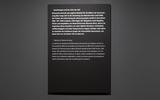
3.3 Preparation errors
These fish were professionally preserved in the 1920s. However, they got damaged because of the lack of regular maintenance. As a result, the specimens have begun to disintegrate, with fat and proteins from their bodies making the preserving liquid cloudy. Mould is also visible on the lid.
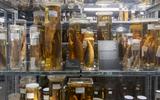
3.4 Steinmann-Eawag collection: A window into past diversity
This collection provides a unique glimpse into fish diversity in Switzerland between 1871 and 1953. It shows how rich Swiss waters were before extensive water pollution led several fish species to go extinct. It is the most significant historical reference collection for current research of the native fish diversity in Switzerland. Despite its importance, it was nearly thrown away. Fortunately, a researcher stepped in and saved the scientific treasure. The collection eventually found its way to our museum, where it was painstakingly restored by experts.
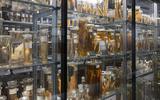
3.5 Documenting the loss
The Steinmann-Eawag collection shows the effect on fish diversity of the increase of water pollution after World War II. Six whitefish species have disappeared due to pollution. Phosphates from washing detergents, manure from agricultural fields and untreated residual waters massively increased the nutrients in the lakes and rivers and the resulting algal blooms literally depleted the air in the water. Some whitefish species that live in deep, clear, oxygen-rich water, went extinct as a result. While steps were taken to reduce pollution, new threats are now emerging.
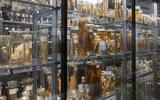
3.6 Priceless rarities:
Many whitefish species are restricted to one or a few lakes, so their local extinction actually means that that they are lost to the world forever. Scientific collections contain just a few specimens of extinct whitefish species –
the only evidence these species ever existed.
